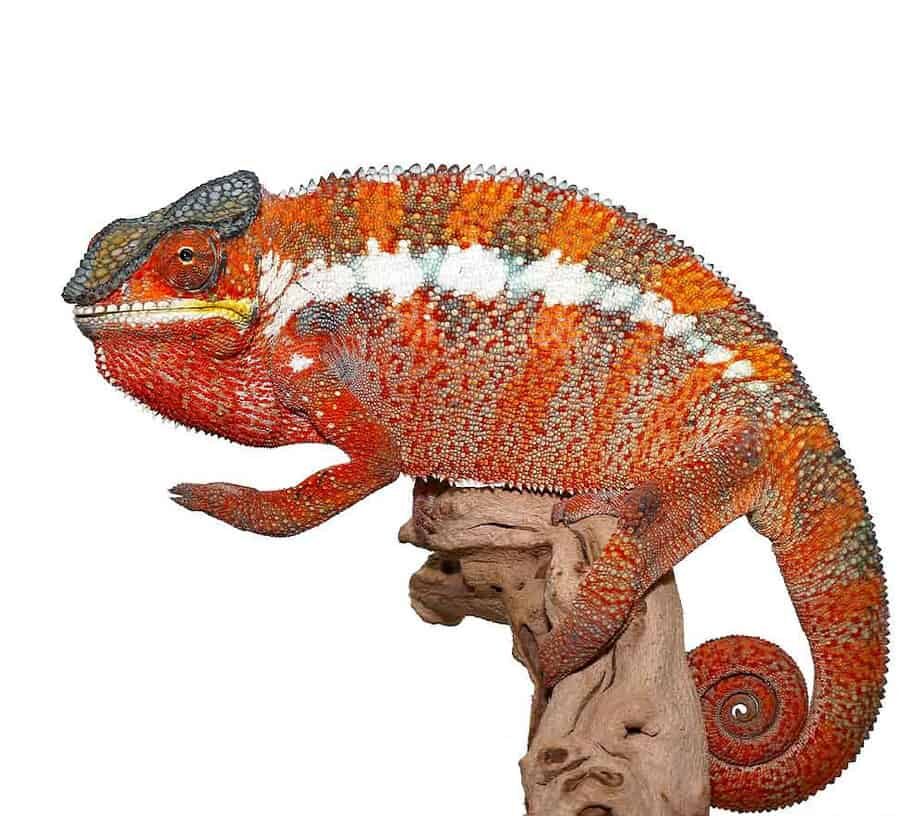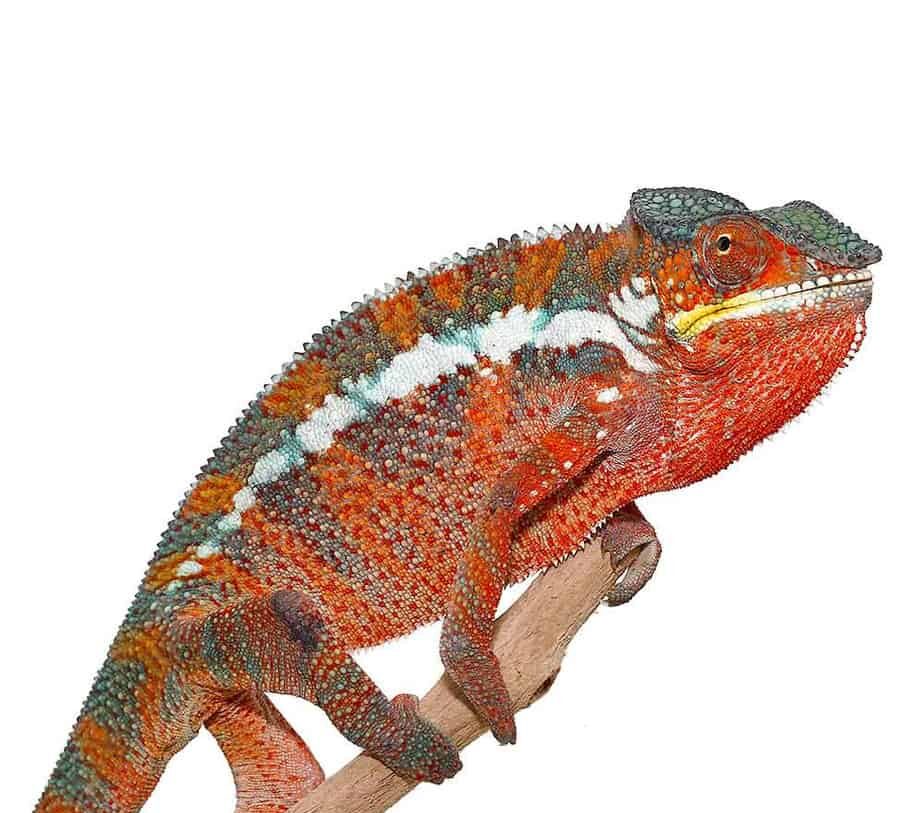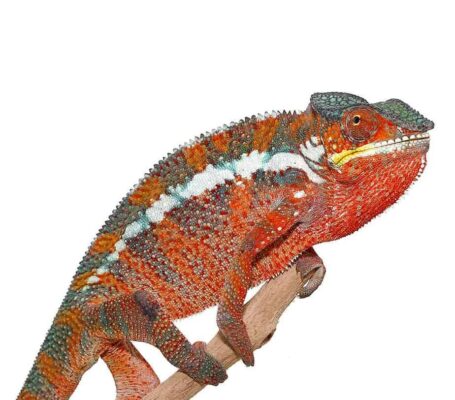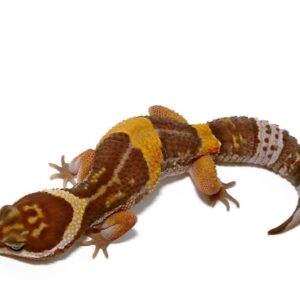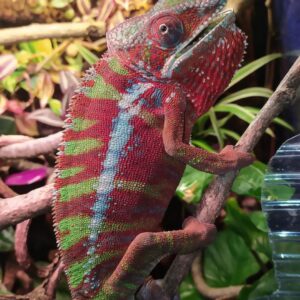Tamatave Panther Chameleon For Sale
$449.99
WE HAVE TAMATAVE PANTHER CHAMELEON FOR SALE. HERE ARE SOME HIGHLIGHTS:
- Furcifer pardalis
- Captive Bred
- Males and Females
- Approximate Sizes Ranging From 12 – 18 In Length
- Adults Are Averaging Around 12 – 18 Inches In Total Length
- Feeding On Vitamin Dusted Crickets, Worms And Roaches
FUN FACTS!
- This Is One Of The Most Popular Species Of Chameleons Due To Their Extreme Coloration
- Males Chameleons Display The Brighter Colors With Females Typically Being More Plain
- Originating From Madagascar These Range From The Coastal Central To Northeastern Madagascar
- With Proper Care They Can Live Up To 3 – 5 Years
- Arboreal Species, Provide Plenty Of Fake Plants And Branches
- A Misting Or Dripping System For Water Is Best, Manual Misting Also Works
Description
Tamatave Panther Chameleons, scientifically known as Furcifer pardalis, are among the most captivating reptiles in the world. These chameleons, native to the Tamatave region in Madagascar, are renowned for their vibrant and diverse coloration, which makes them a focal point in both scientific studies and the exotic pet trade. Their ability to change colors is not just a visual spectacle but also a vital adaptation for communication, camouflage, and temperature regulation.
Characterized by a robust body, these chameleons exhibit a range of hues from vivid blues and greens to intense reds and yellows, depending on factors such as mood, health, and environmental conditions. The males are particularly noted for their striking color patterns, which they use to attract mates and ward off rivals. Females, while generally less colorful, can still display a remarkable palette, especially when gravid or stressed.
In the reptile world, Tamatave Panther Chameleons hold a significant place due to their unique physiological and behavioral traits. Their zygodactylous feet, prehensile tails, and independently mobile eyes are marvels of evolutionary adaptation, enabling them to navigate and hunt in their arboreal habitats with precision. Moreover, their diet primarily consists of insects, which they capture with their long, sticky tongues in a display of remarkable speed and accuracy.
Their popularity among reptile enthusiasts has also highlighted the importance of sustainable practices in the pet trade. Efforts to breed them in captivity have been successful, reducing the pressure on wild populations and promoting conservation awareness. These chameleons serve as ambassadors for the rich biodiversity of Madagascar, underscoring the need to protect their natural habitats from deforestation and other environmental threats.
Overall, Tamatave Panther Chameleons are not only visually stunning but also fascinating in their biology and ecology, making them a subject of great interest for both researchers and reptile aficionados alike.
Native Habitat and Distribution
The Tamatave Panther Chameleon, scientifically known as Furcifer pardalis, finds its native habitat in the biodiverse region of Madagascar. Specifically, these captivating reptiles are commonly found in the eastern parts of the island, with a significant concentration in the coastal city of Tamatave (Toamasina). This region offers a unique blend of environmental conditions that are crucial for their survival and proliferation.
Madagascar’s eastern rainforests provide an ideal environment for the Tamatave Panther Chameleons. These dense, humid forests are rich in foliage, offering ample opportunities for these chameleons to camouflage and hunt for their prey. The lush vegetation also provides necessary shelter from predators and harsh weather conditions. The high humidity and consistent rainfall in these rainforests create a stable, moist atmosphere, which is essential for the chameleons’ skin health and hydration.
In addition to rainforests, Tamatave Panther Chameleons are also found in coastal areas. The coastal regions of Madagascar present a slightly different habitat, characterized by mangrove swamps and coastal scrublands. These areas, though less dense than rainforests, still offer adequate cover and a rich supply of insects, which constitute the primary diet of these chameleons. The proximity to the ocean influences the coastal climate, providing a relatively stable temperature range and humidity levels conducive to the chameleons’ needs.
The specific environmental conditions of both rainforests and coastal regions play a pivotal role in the distribution and thriving of Tamatave Panther Chameleons. These habitats not only support their physical requirements but also foster a diverse ecosystem where they can interact with other native species. Understanding the native habitat and distribution of these chameleons is crucial for their conservation and for maintaining the ecological balance in Madagascar.
Physical Characteristics and Coloration
Tamatave Panther Chameleons, scientifically known as Furcifer pardalis, are renowned for their striking physical characteristics and vibrant coloration. These chameleons typically reach a length of 15 to 20 inches, with males generally being larger and more vividly colored than females. The body shape of the Tamatave Panther Chameleon is characterized by a laterally compressed torso, slender limbs, and a prehensile tail that aids in balance and climbing.
One of the most captivating aspects of the Tamatave Panther Chameleon is its stunning coloration. Males often display a dazzling array of bright reds and oranges, interspersed with greens and blues, creating an almost kaleidoscopic effect. Females, while generally more subdued in color, can still exhibit beautiful shades of pink and orange. The coloration of these chameleons is not just for show; it serves critical functions such as camouflage, communication, and thermoregulation.
The ability of Tamatave Panther Chameleons to change color is a fascinating physiological adaptation. Unlike popular belief, chameleons do not change color to match their surroundings. Instead, the color change is primarily influenced by factors such as light, temperature, and the chameleon’s emotional state. Specialized cells in their skin called chromatophores contain different pigments, and by expanding or contracting these cells, chameleons can produce a wide range of colors and patterns.
In addition to chromatophores, iridophores and leucophores also play a role in the color-changing process. Iridophores reflect light, creating iridescent hues and enhancing the overall brightness of the chameleon’s colors. Leucophores, on the other hand, reflect white light, contributing to the paler shades and adding depth to the color palette. This complex interplay of cellular structures allows Tamatave Panther Chameleons to exhibit their remarkable and ever-changing displays of color.
Behavior and Lifestyle
Tamatave Panther Chameleons display a wide array of intriguing behaviors and routines that highlight their adaptability and uniqueness. In their natural habitat, these chameleons are primarily arboreal, spending most of their time in trees. They are known for their slow, deliberate movements and their remarkable ability to blend into their surroundings, an adaptation that aids in both predation and evasion of predators.
Feeding habits of the Tamatave Panther Chameleon vary between the wild and captivity. In the wild, they primarily consume a diet of insects, such as crickets, locusts, and flies, which they capture with their long, sticky tongues. Occasionally, they may also eat smaller vertebrates or other invertebrates. In captivity, their diet can be more controlled and diverse, often including commercially available insects like mealworms and waxworms, supplemented with vitamins and minerals to ensure proper nutrition.
Socially, Tamatave Panther Chameleons are generally solitary creatures, coming together only for mating purposes. During the breeding season, males exhibit vibrant color changes to attract females and to assert dominance over rival males. These color displays are a key part of their mating rituals, with more dominant males displaying brighter, more intense colors. Once mating is complete, females lay eggs, which they bury in the soil to incubate.
Unique behavioral traits of these chameleons include their ability to independently move each eye, allowing them to have a 360-degree field of vision. This is particularly advantageous for spotting both prey and potential threats. Additionally, their prehensile tails and zygodactylous feet enable them to navigate through the treetops with ease, providing stability and dexterity in their arboreal environment.
Understanding the behavior and lifestyle of Tamatave Panther Chameleons not only enhances our appreciation of these remarkable reptiles but also informs better care practices for those kept in captivity, ensuring they lead healthy, enriched lives.
Reproduction and Lifecycle
The reproductive process of Tamatave Panther Chameleons is a complex and fascinating journey, beginning with an elaborate courtship ritual. During the breeding season, males exhibit vibrant color displays and perform a series of head-bobbing and swaying motions to attract potential mates. This visual spectacle serves both to entice females and to ward off rival males. Once a female is receptive, mating occurs, and the female subsequently begins the process of egg-laying.
Female Tamatave Panther Chameleons lay their eggs approximately 20 to 30 days after mating. They seek out a suitable, moist substrate to dig a burrow where they will deposit their clutch of eggs, which can range from 10 to 40 eggs depending on the age and health of the female. After laying the eggs, the female covers the burrow to protect them from predators and environmental hazards. The incubation period for the eggs is typically around 6 to 12 months, influenced by temperature and humidity conditions.
Upon hatching, the young chameleons, known as hatchlings, are fully independent and must fend for themselves immediately. They are miniature versions of their parents but lack the vivid coloration that will develop as they mature. The initial growth phase is rapid, and within three to six months, juveniles will start showing more distinct patterns and colors. This stage is critical as young chameleons are vulnerable to predation and require ample food and proper environmental conditions to thrive.
As they transition from juveniles to subadults, their growth rate slows, and they continue to develop their characteristic markings and vibrant hues. By the time they reach 12 to 18 months of age, Tamatave Panther Chameleons are generally considered adults, capable of reproduction. Throughout their lifecycle, these chameleons face several challenges, including predation, habitat loss, and climate variations, which can impact their survival and reproductive success.
Understanding the reproductive process and lifecycle of Tamatave Panther Chameleons is vital for their conservation and care, ensuring these captivating creatures continue to thrive in their natural habitats and in captivity.
Care and Maintenance in Captivity
Caring for Tamatave Panther Chameleons in captivity requires a precise understanding of their natural habitat to ensure their optimal health and longevity. Creating an appropriate environment is crucial. A well-ventilated terrarium, ideally sized at least 24x24x48 inches, provides ample space for climbing and exploration. Vertical space is particularly important due to their arboreal nature. The enclosure should be furnished with a variety of branches and live or artificial plants to simulate their natural surroundings and provide necessary hiding spots.
Temperature regulation is vital. A daytime temperature gradient of 75°F to 85°F, with a basking spot reaching up to 90°F, is recommended. Nighttime temperatures should drop to around 65°F to 70°F. These conditions can be achieved using a combination of basking lamps and ceramic heat emitters. Humidity levels should be maintained between 60% and 80%, achieved through regular misting and the use of a drip system. Proper lighting, including UVB light, is essential for their metabolic processes and overall well-being. A 12-hour light-dark cycle mimics natural conditions.
Dietary needs are another critical aspect of caring for Tamatave Panther Chameleons. Their diet primarily consists of live insects such as crickets, roaches, and mealworms, dusted with calcium and multivitamin supplements to prevent deficiencies. Offering a variety of prey items ensures balanced nutrition. Adult chameleons should be fed every other day, while juveniles require daily feeding to support their rapid growth.
Common health concerns in captivity include metabolic bone disease, respiratory infections, and parasitic infestations. Regular health check-ups with a reptile veterinarian, along with vigilant observation of any changes in behavior or appearance, are key to early detection and treatment of health issues. Maintaining cleanliness in the enclosure by removing uneaten food and waste helps prevent bacterial and fungal infections.
By adhering to these guidelines and maintaining a close watch on their well-being, owners can provide a conducive environment for Tamatave Panther Chameleons, ensuring they thrive in captivity. Proper care and maintenance are fundamental to the health and happiness of these captivating reptiles.
Conservation Status and Threats
The Tamatave Panther Chameleon (Furcifer pardalis) is a remarkable reptile native to the forests of Madagascar. Unfortunately, its survival is increasingly threatened by several factors. Classified as “Least Concern” by the International Union for Conservation of Nature (IUCN), this status belies the numerous challenges that these chameleons face in their natural habitat.
One of the primary threats to the Tamatave Panther Chameleon is habitat destruction. Deforestation for agriculture, logging, and urban development has significantly reduced the chameleon’s natural habitat. Madagascar’s forests, home to this species, are disappearing at an alarming rate, leaving limited space for the chameleons to live and thrive.
Climate change further exacerbates these challenges. Shifts in temperature and precipitation patterns disrupt the delicate balance of the forest ecosystems. Such changes can impair the chameleon’s ability to find food and suitable breeding conditions, ultimately affecting their population numbers.
The pet trade also poses a significant threat to the Tamatave Panther Chameleon. Due to their vivid and striking coloration, these chameleons are highly sought after in the exotic pet market. Over-collection from the wild can lead to population declines and disrupt the ecological balance within their native habitat. While there are regulations in place to control the trade, illegal trafficking remains a persistent problem.
Conservation efforts are crucial in mitigating these threats. Organizations such as the Madagascar Biodiversity Partnership and the Durrell Wildlife Conservation Trust are actively involved in habitat restoration projects and community education programs aimed at promoting sustainable practices. Additionally, captive breeding programs in zoos and specialized breeding centers are helping to reduce the pressure on wild populations by providing an alternative source for the pet trade.
In conclusion, while the Tamatave Panther Chameleon faces numerous threats in the wild, concerted conservation efforts and increased awareness can play a pivotal role in ensuring the survival of this magnificent species for future generations.
Interesting Facts and Myths
Tamatave Panther Chameleons, scientifically known as Furcifer pardalis, are a captivating species native to Madagascar’s eastern coast. These chameleons are renowned for their vibrant colors, which can range from bright reds and blues to striking oranges and greens. One of the intriguing aspects of their biology is their ability to change color, not just for camouflage but also as a response to temperature, light, and emotional state. This color-changing ability is due to specialized cells called chromatophores, which expand and contract to alter the chameleon’s hue.
A common myth about Tamatave Panther Chameleons is that they can blend into any background instantaneously. While they are adept at changing colors, their color palette is limited, and the process is not as instantaneous as popular culture often suggests. The primary purpose of their color change is communication, especially during mating rituals or territorial disputes.
Another interesting fact is that Tamatave Panther Chameleons have a unique way of hunting. Unlike many reptiles, they rely heavily on their vision to catch prey. Their eyes can move independently, allowing them to have a 360-degree view of their surroundings. Once they spot their target, they can focus both eyes in the same direction to gauge distance accurately. They then use their long, sticky tongue, which can be up to twice the length of their body, to snatch insects with remarkable speed and precision.
In terms of behavior, Tamatave Panther Chameleons are generally solitary creatures. They have a relatively short lifespan, averaging about 5-7 years in captivity, though some can live slightly longer with proper care. Their solitary nature and specific environmental needs make them a challenging but rewarding pet for experienced reptile enthusiasts.
To end with a few fun facts: Did you know that Tamatave Panther Chameleons have zygodactylous feet, meaning their toes are grouped in opposing pairs to better grip branches? Also, their tails are prehensile, which helps them maintain balance and stability in their arboreal habitat. Lastly, despite their fierce appearance, these chameleons are generally harmless to humans, making them a fascinating subject for both amateur and professional herpetologists.

